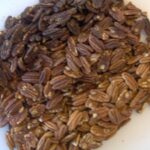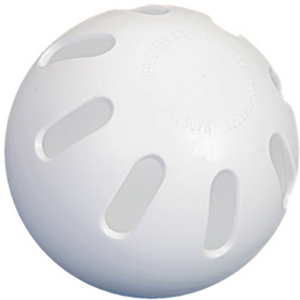When Hurricane Katrina hit New Orleans in August of 2005–most people elsewhere thought so many of the amazing traditions and people of The Big Easy would tragically be lost forever. Despite so much suffering still happening in the region–one of the lesser-talked-about aspects to New Orleans culture surviving post-Katrina is the apparent continued production there of one of my favorite candies in the known universe: Pralines. If you’ve never tasted this New Orleans-originated confection, you’re in for one of the best sweet-tasting blasts of your life…especially if you’re a fan of a combination taste of butter, brown sugar and pecans.
Many of them are produced in the shape of a disk–with the pralines plainly visible on top–yet baked right in to the cooked sugar on the surface. They generally get made into the diameter of what a medium-size flapjack would look like, but with cragged edges. And they usually get wrapped individually…considering eating just one would probably ruin someone’s diet (or even weakened arteries) within ten minutes. Obviously, I wouldn’t recommend eating them if you’re on a strict diet, have Diabetes or have to stay away from fat for the sake of your health. Everybody else (yeah, ok, we won’t gloat) has to try at least one in their lifetime to be considered a true blue American. Even though I’ve actually never visited New Orleans, I’ve had the good fortune of having pralines sent to me from friends who visited there. The search to get more without having to leave the state has been ongoing. That Holy Confection search only matters more when you’re not sure they’re being produced in New Orleans any longer.
Based on the name–you probably guessed that these confections originated with the French influences that permeated ‘Nawlins back in the 1700’s. As usual, with a place so full of tradition, New Orleans has dozens of differing tales about how the praline came to be invented. But the more or less official story is that it was named via a 1600’s French Diplomat (Cesar du Plessis Praslin) and concocted by a brilliant chef who was working in his manor. Whoever that chef was should get some kind of posthumous recognition through his descendants if he actually existed. Whoever he was, he came up with the idea of taking almonds and coating them in cooked sugar. For those of us who have inventive chefs in our families–we know what it’s like to experience a happy accident culinary creation in the kitchen. I’ve had the pleasurable fortune of having that experience with my own family. In the French diplomat’s case, the rumor is that they were possibly just made as a possible digestive aid.
Well, the better story is that the French diplomat had the chef make them as something unique to give as a gift to his lady…suitors. That diplomat was probably fairly popular with the women of the region after passing those out…particularly if he took credit for creating the candy. Whether he named them after himself then, it isn’t really known. Somehow I picture a pompous nose-raised French diplomat doing exactly that just to get himself into the arms and bed of the beautiful women in the city.
The praline becomes a popular item to sell from free pre-Civil War African-American women…
Picturing an older African-American woman selling pralines is pretty much how most people (who’ve read at least some history of the praline) think of when seeing them being sold. Today, it’s still that way to an extent–though African-American men (as well as everybody) also sell them along the streets of the city. Back before the Civil War, though, it became a true American pastime to see older black women selling little packages of pralines on the streets of the Old French Quarter. The legend of this nearly “Gone with the Wind”-like piece of southern history gives the images of these women wearing white aprons and head wraps (called tignons) as they chanted out “belles pralines!” as a way to remind us of the French influence on the African-American culture there.
All of that seems so idyllic and appealingly American in every sense of the word–even though it’s a miracle people didn’t rename Pralines “Tasty Nut Clusters” as a backlash against the French during that silly anti-French rally after 9/11. Yes, we can thank the French for starting this confection–or at least that chef to the diplomat who was assumedly French. Or maybe he was African-American, which would prove yet again that the black culture invented so much to give our identity as Americans.
Well, the African-American culture in New Orleans DID help spread the addictive qualities of the candy all around the city if they didn’t invent pralines directly. By the time of Reconstruction during the 1880’s–stores that produced pralines were seen on every street corner. Some became so popular that they still exist today in the French Quarter around famous Chartre and Decatur Streets.
Buying pralines via the convenience of the internet…
If you can’t go down to visit New Orleans directly, then there are various candy stores producing pralines who have websites. Just do a Google search and you’ll find numerous ones who will send pralines to you via mail. I haven’t been on some of them in several years, though, and a few may have been wiped out by Katrina. While you could apparently get pralines in any gift shop, general or convenience store in the New Orleans area prior to 2006, it’s the small candy makers who’ve been around for decades people need to visit in order to get the true experience of eating a praline. Those little places have secret recipes, too, that can’t be duplicated by others. They’re also supposed to have display windows where you can watch them being made–as well as allowing people inside to take a whiff of the highly-appealing scent freshly-cooked pralines create.
Whether these little shops that produce traditional pralines still exist is unknown as of this writing. As with Mardi Gras and just about everything else in New Orleans after Katrina, some elements of it probably still exist. Pralines might be slightly more of a commodity now–all due to tragic circumstance.
Even if they are rarer now–maybe it’s a good plan so people realize how unique pralines are. In a time when Americans are already addicted to high-calorie foods and sugar–the chance to truly savor just one when you can get a few might be the best kind of willpower from indulging.
___
Here’s the recipe for traditional New Orleans pralines if you ever want to try making them on you own (which isn’t necessarily recommended):
–1 cup light brown sugar, packed
–1 cup granulated sugar
–½ cup light cream
–1 ½ cups pecans, halved
–2 tablespoons butter
–Combine sugars and cream in a heavy 2-quart saucepan and bring to boil over medium heat, stirring occasionally with a wooden spoon, until mixture forms a thick syrup.
–Add pecans and butter and continue to cook over medium heat, stirring frequently.
–Remove sauce pan to a heatproof surface (such as a wire rack) and let cool for 10 minutes.
–Use a tablespoon to drop rounded balls of the mixture onto sheet wax paper or foil, leaving about 3 inches between each ball for pralines to spread. Allow to cool.
–This makes about 12 candies.
(Recipe courtesy of Frenchquarter.com)






